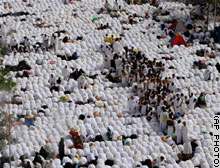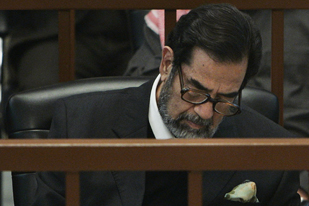Even though it does its best to appear to be presenting news in a non-biased way, the media has a large tendency to slant stories to reflect their viewpoint, either consciously or unconsciously. There is a great deal of danger in assuming that the information provided in the media, even information provided in a 24-hour real-time scenario, is the only ‘true’ understanding of what is happening. It was this sort of understanding Napoleon Bonaparte had of the ‘Orientals’ of his day causing him to vastly misunderstand the ‘Orient’ as it truly was at that time. Despite this seemingly impossible-to-miss discrepancy in understandings, Western people entering the true Orient were already convinced of what they knew regarding an unchanging and already defined system. They locked everything labeled ‘Oriental’ into a concept of a passive, unresisting object for study with no identification of its own. This caused them to see only what they wished to see because they focused on those elements that proved their assumptions and ignored elements that challenged them. Comparable linguistics was the basis for many of these assumptions. This had, and continues to have, a negative effect upon the Western world’s perception, understanding and appreciation of a multitude of cultures that were erroneously grouped into a single identity. A look at how the media coverage of the same sequence of events, the trial and execution of Saddam Hussein, was handled by two different media sources can illustrate the ways in which the same event can be portrayed in entirely different ways.
These concepts can be traced in the ways in which the Muslim society, and Iraqi people as a whole, have been portrayed in the Western media, especially since the Twin Towers were attacked in New York on September 11, 2001. In Western media outlets, the people of the Middle East have continuously been portrayed as either unjustifiably threatening or somehow inferior to Western cultures. For example, a picture of a large group of Hajj pilgrims kneeling at their prayers is used to illustrate a feature story regarding their protest on the timing of Saddam’s execution on the first of one of their holy days (Fig. 1). The title of the story is “Hanging anger Arab hajj pilgrims” but none of the anger can be seen because the picture is taken from so far above the crowd. There is no chance to see any detail of the men’s faces or even any understanding of what they are doing. Instead, the viewer gets the impression that this ‘angry’ crowd is no more threatening than a flock of sheep, an image reinforced by the mass of white-robed backs bent in reverent prayer pictured.

Discussing the same story, the image published by the Iraqi Al-Jezeera network depicts a more active image brought into equal status with the viewer by being taken at near street level (Fig. 2). At this level, the camera can focus more on the emotions of the people involved. The photo captures a moment during a traditional stone-throwing ritual. Because it is part of a ritual, it is portrayed as being non-threatening due to present circumstances, but because of the moment captured, the newspaper is able to convey some of the anger felt by the crowd. The shape of the man’s hand in the forefront of the image indicates that he has just released his stone. His hand is the element perceived to be closest to the viewer in the available picture plane, still formed into the shape of a claw. This sensitive approach to the illustration shows both the reverence of this individual for his faith as well as the potential for this individual to raise his hand in anger toward those who have determined to ignore his culture and beliefs.

This same difference of portrayal from one media outlet to another can be seen in a comparison of the former Iraqi leader Saddam Hussein as he participated in his court trial. Images of Hussein during the trial broadcast in the West tended to focus on his negative moods and attributes. In Figure 3 (below), an international news organization based predominantly in the Western nations captures a moment when Saddam is incredibly angry, demanding and unrepentant. His finger is pointing toward the camera and his contorted facial expressions give the impression that he is accusing when many people in the West felt he should be listening contritely as a man who knew he had erred. His open mouth emphasizes the impression that he is giving his own lecture and thus speaking out of place, attempting to assume the role of the parent rather than a child. Because of the superior assumptions made by many in the Western culture, this posture takes on an additional negative overtone as no one likes to be chastised by their inferiors. All of these assumptions are made with the image alone before any text is read. By using this image to illustrate a story regarding the impending execution, the media outlet is able to reinforce the idea that this is a man incapable of repenting his misdeeds appropriately and thus must be eliminated.

In direct contrast again, Figure 4 shows a much more thoughtful and intelligent man sitting calmly at his trial and studiously attending to the proceedings. In this image taken from the Al-Jezeera network, Saddam is seen wearing glasses, looking down and wearing an expression of concentration. He is calm and composed, representing a very different man from the one pictured in the American media. Although he might not be contrite, he is a man carefully considering his defense, intelligently listening to his accusers, and studiously representing his country. While it is true that the two images were taken at different points in the trial, during which the attitude of the former leader might have changed, it is equally true that photographers on both sides had numerous options for images to use for the illustration of their story throughout either trial date. The significance is not in the different moods and expressions of Saddam during the course of the trial, but instead in the choices made by these photographers and their organizations in the visual messages sent, indicating the intention of these organizations in defining a pre-determined image they wished to portray.

Coverage of the execution of Saddam also differed from one media organization to another. While the Western-oriented news organization CNN covered the event in terms of a celebration and a final solution, the Al-Jezeera network covered a broader scope of issues surrounding the hanging and its timing. They also portrayed Saddam’s final moments in a more sympathetic light, with little of the bloodlust that seems apparent in Western coverage. CNN touched on issues such as custody control and cooperative relations with the new Iraqi government, Al-Jezeera covered perhaps more disturbing issues such as protests regarding the timing of the execution on the first day of a sacred Muslim holiday period and improprieties that occurred on the day of the execution. Likewise, the illustrations used to highlight these stories varied to a great degree and focus. Figure 5 was the image used by Al-Jezeera to illustrate their story regarding Saddam’s final moments as he was plagued by jeers and catcalls from the surrounding crowd. Despite this, the frontal view of his face seems to be calm and fearless. Although the image is fuzzy and difficult to make out much detail, it seems as though Saddam is serene with himself. The accompanying report indicates he exchanged insults with those in attendance and died reciting his prayers, both of which support the image thus portrayed.

Figure 6 shows another angle on Hussein’s final moments as an illustration for a Western-backed international story covering the execution. Like the image used in the Al-Jezeera network, the CNN image is difficult to make out and the angle of the shot, taken from almost behind the former leader’s head to the left, makes it even more difficult to determine any kind of emotion the man might be feeling. Despite this, the title of the article confidently proclaims “Hussein executed with ‘fear in his face’” (2006). Yet, the caption for the image indicates Saddam refused to wear a hood as is typical for prisoners about to be executed by hanging, which does not necessarily indicate a man struggling with fearful emotions.

The philosopher Edward Said indicates that these types of mis-portrayals carried by the Western media are not always necessarily as deliberate as these images might at first suggest. He attests within his novel Orientalism that there is no such thing as pure knowledge because “no one has ever devised a method for detaching the scholar from the circumstances of life, from the fact of his involvement (conscious or unconscious) with a class, a set of beliefs, a social position, or from the mere activity of being a member of a society” (Said, 1979, p. 10). Because the concept of Orientalism is such an ingrained concept in the minds of the Western world, Said argues that it is impossible for a Western writer, regardless of genre or intent, to approach the topic from the perspective of an individual without first coming upon the topic as a Westerner. One of the modern means of interpreting a text involves the process of Deconstruction, a process that had already been labeled and in use when Said wrote his book. Despite the various things that can be learned through this process, it is argued that “texts cannot be deconstructed from ‘within’. For one thing, this would involve the inescapable loops of recursion: each attempt at deconstruction would need deconstructing. And quite apart from its logical absurdity, any such attempt would also be an epistemological impossibility, since (as Derrida would point out) authors cannot fully understand what they have written: the deep ground of the ideas which underlies the text is forever invisible and inaccessible to the author” (Chandler, 1995, p. 228). Indeed, Said argues that the concept of the Orient as it has been created within the minds of the West is so ingrained in so many facets of Western life that it manifests itself through the intertextual context and is indistinguishable to the Western writer from his own “pure” thought.
These ideas have since been supported by numerous other writers looking into the various ways in which the West tends to conceptualize the ‘other’ in pre-determined understandings. Ziauddin Sardar in his book, also entitled Orientalism, said, “It was in its encounter with Islam that the West first developed its vision of the Orient as an unfathomable, exotic and erotic place where mysteries dwell and cruel and barbaric scenes are staged” (1999, p. 2). The approach Said outlines in studying these works includes consideration of the authority with which the author wrote including “strategic location, which is a way of describing the author’s position in a text with regard to the Oriental material he writes about, and strategic formation, which is a way of analyzing the relationship between texts and the way in which groups of texts, even textual genres, acquire mass, density, and referential power among themselves and thereafter in the culture at large” (Said, 1979, p. 20). To distinguish how these texts establish their authority, Said indicates it is necessary to study the “style, figures of speech, setting, narrative devices, historical and social circumstances, not the correctness of the representation nor its fidelity to some great original”(Said, 1979, p. 21) for evidence of the exteriority of the representation, ideas quickly accessible through studying the photographs involved.
While the concept of Orientalism in the media is relatively easy to see once it is pointed out, it is not so easily transferred as a concept to less obvious means of expression and used with less conscious intention. For example, these same processes are at work in the West’s definition of ‘female’ and ‘male’, in determining whether it is okay for a man to wear something pink or a woman to have a ‘boys’ haircut. In numerous different ways throughout the various media channels, these ideas are expressed and reinforced in a thousand different ways to such a degree that they will perhaps never be fully removed. Because everyone, including the photographer, the cameraman, the reporter, and the blogger, can only see the world through their own set of eyes, complete with their own biases, expectations, and understandings, it can never be said that a single media source can reflect the truth of a given event.
References
Chandler, Daniel. (1995). The Act of Writing. Aberystwyth, University of Wales.
“Hanging angers Arab hajj pilgrims.” (2006). CNN.
“Hussein executed with ‘fear in his face.’” (2006). CNN.
“Saddam appears in genocide trial.” (2006). Al-Jezeera.
“Saddam execution angers pilgrims.” (2006). Al-Jezeera.
Said, Edward. (1979). Orientalism. New York: Vintage Books.
Sardar, Ziauddin. (1999). Orientalism. Buckingham: Open University Press.
“US Officials: Hussein execution this weekend.” (2006). CNN.